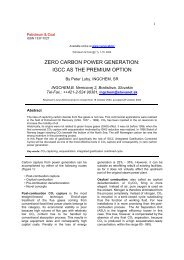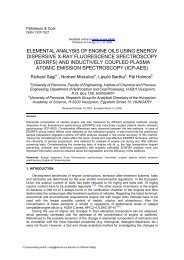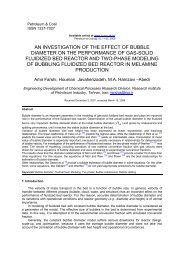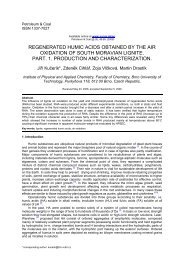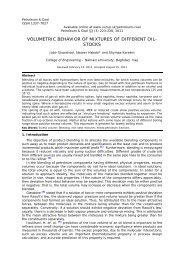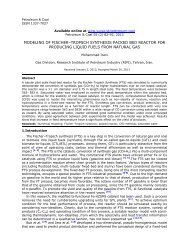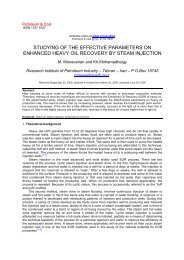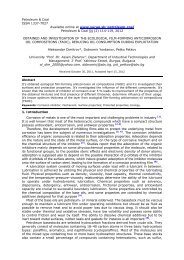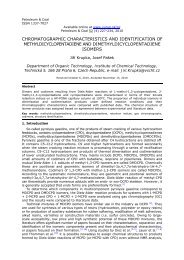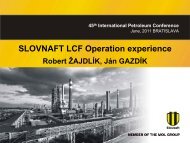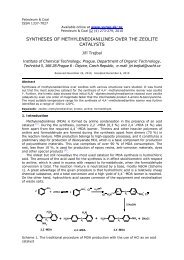Thermal cracking of waste biomass/plastics mixtures
Thermal cracking of waste biomass/plastics mixtures
Thermal cracking of waste biomass/plastics mixtures
You also want an ePaper? Increase the reach of your titles
YUMPU automatically turns print PDFs into web optimized ePapers that Google loves.
Table 4. Composition <strong>of</strong> feedstock samplesSampleComposition (%wt.)LLDPE LDPE HDPE PP PS PET PVC beech used tireswood1 22.9 22.9 22.9 9.5 9.5 10.7 1.1 0 02 0 0 0 0 0 0 0 100 03 0 0 0 0 0 0 0 0 1004 11.5 11.5 11.5 4.8 4.8 5.3 0.5 50 05 11.5 11.5 11.5 4.8 4.8 5.3 0.5 0 506 0 0 0 0 0 0 0 50 507 7.7 7.7 7.7 3.2 3.2 3.5 0.4 33.4 33.43. Results and DiscusionIn gas products we focused on quantitative analysis <strong>of</strong> carbon monoxide, carbon dioxide,methan, ethan, ethylene, propane, propene and hydrogen. In liquid products from mixture <strong>of</strong><strong>plastics</strong> we focused on 1-alkenes and alkanes, from beech wood on oxygene derivates andfrom tires on aromates and isoprene (Table 5.). We compared yields with previous study.There are differences in yields <strong>of</strong> carbon monoxide and carbon dioxide in this study (traces)in comparison with the prewious study [4]. Yields <strong>of</strong> other main products from thermal<strong>cracking</strong> <strong>of</strong> plastic <strong>mixtures</strong> were increased. There is a compilance with study [7] in yields <strong>of</strong>carbon oxides in the gas fraction from pyrolysis if beech wood. In liquid fraction from usedtires pyrolysis we noted increased yields <strong>of</strong> aromatics compared with study [5].Material balance was calculated after each experiment. These dates are given in table6.
Table 5. Comparison <strong>of</strong> yields <strong>of</strong> main agents for individually materialsSample/component1 2 3 4 5 6 7exp. [4] exp. [7] exp. [5] exp. [8] exp. exp. exp.Yields <strong>of</strong> gaseous components [%wt.]Carbon oxide traces 0.6 3.5 12.9 0.3 0.7 0.2 1.7 0.3 2.6 0.3Carbon dioxide traces 6.8 16.6 8.7 3.7 5.2 19.4 24.6 4.7 2.6 11.4Hydrogen - - - traces 0.2 - - - traces -Methane 1.6 1.0 1.2 1.9 0.8 1.0 0.4 1.2 0.4 1.3 0.3Ethane 6.6 2.7 0.7 0.4 1.1 0.7 0.6 0.4 1.0 1.9 0.2Ethylene 4.5 3.9 0.3 0.3 0.4 0.5 0.3 0.6 0.5 1.1 0.1Propane 11.6 2.6 0.3 0.1 1.2 0.6 0.5 0.2 1.4 2.7 0.1Propene 14.3 6.4 0.4 0.3 1.0 0.9 0.6 0.4 1.6 3.2 0.2Yields <strong>of</strong> liquid components [%wt.]1-Heptene- 3.7 - - - - 3.9 1.3 0.4 - 0.5+heptane1-Octene2.0 3.0 - - - - 0.2 0.9 0.8 - -+octane1-Tetradecene 1.0 2.0 - - - - traces 0.9 - - -+tetradecane1-Hexadecene 0.6 1.1 - - - - - 0.4 0.9 - 0.3+hexadecane1-Heptadecene 0.7 1.0 - - - - - 0.2 - - -+heptadecaneMethanol - - 4.3 0,6 - - 1.4 3.9 - 3.7 -Acetic acid - - 13.5 4,3 - - 3.4 2.6 - 0.7 -Formic acid - - 2.1 4,7 - - 0.6 1.4 - 8.2 -Furfural - - 1.0 2,4 - - 0.2 1.5 - 0.5 -Lactic acid - - 0.4 1,0 - - 0.9 0.4 - - -Phenol - - 0.3 - - - traces 1.4 - - -Levoglukosane - - 0.8 0.4 - - - 0.4 - - -Benzene - - - - 9.3 3.2 - - - - -Isoprene - - - - 11.1 5.0 - - 4.7 1.8 2.2Toluene - - - - 5.8 2.1 - - 3.9 2.9 8.3Ethylbenzene - - - - 0.2 1.0 - - 0.1 - -p+m-Xylene - - - - 0.5 1.2 - 2.0 0.3 - -Methylstyrene - - - - 0.2 1.2 - - 1.6 - -d,l-Limonene - - - - 2.7 9.0 - - 3.6 0.9 1.6Naphthalene - - - - 0.1 1.7 - - - 1.5 -Other componentsin gas and liquidproducts57.1 65.2 54.6 62.0 61.4 66.0 67.4 53.8 73.8 64.4 74.5Table 6. The comparison <strong>of</strong> experimental and theroetical yields <strong>of</strong> gases, liquids and solidresidueSample 1 2 3 4 5 6 7exp. [4] exp. [7] exp. [5] exp. teor. [8] exp. teor. exp. teor. exp. teor.Gas 28.4 30.5 35.4 25.1 16.4 11.1 35.7 31.9 30.3 17.4 22.4 29.8 25.9 16.9 26.7Liquid 70.5 65.9 40.5 44.3 48.9 42.6 49.0 55.5 43.8 48.5 59.7 34.3 44.7 53.7 53.2Solid residue 1.2 3.6 24.1 30.6 34.7 46.3 15.3 12.6 25.9 34.1 17.9 35.9 29.4 29.4 20.0
The yields <strong>of</strong> gas, liquid and solid residue from pyrolysis <strong>of</strong> plastic mixture areidentical as in study [4]. Differences in this study and in previous study <strong>of</strong> beech woodpyrolysis is in increased yield <strong>of</strong> gas fraction and reduced yield <strong>of</strong> liquid fraction and solidresidue [7].By the pyrolysis <strong>of</strong> <strong>plastics</strong> and wood <strong>mixtures</strong> (1:1) was noted a deviation from thetheoertical estimates. The reduction <strong>of</strong> oxygene species was also noted. This decreasingmeans, that the addition <strong>of</strong> <strong>plastics</strong> into the feed caused the decomposition <strong>of</strong> oxygen speciesto carbon monoxide. Sharypov et al.[9] reported that the production <strong>of</strong> carbon monoxidecould be reduced to value <strong>of</strong> 6.5 wt% by using a mixture which contains beech wood andpolypropylene 1:1. The reactor was a rotary autoclave from stainlass steel. The perssure in thereactor was 3 MPa, max. 5.5 MPa. Ouminiga et al.[10] reported that higher yields <strong>of</strong> carbonoxides could be achieved by flash pyrolysis at temperatures <strong>of</strong> 800-1000°C. The amount <strong>of</strong>carbon dioxide was 7-12 wt% and <strong>of</strong> carbon monoxide was 19-26%. The yield <strong>of</strong> methanewas higher: 7-9 wt%, and the yields <strong>of</strong> other hydrocarbons were decreased.4. ConclusionThe possibilities <strong>of</strong> pyrolysis and copyrolysis in the recycling <strong>of</strong> <strong>plastics</strong>, <strong>biomass</strong>, usedtires and its <strong>mixtures</strong> were studied. We have also registered the possible dependences anddifferences between the theoretical and calculated values <strong>of</strong> yield for gases, liquids and solidresidue as well as individual products.AcknowledgmentWewould like to thank the VEGA Scientific Grant <strong>of</strong> the Slovak Republic, for financialsupport <strong>of</strong> this research through the Research Project No. 1/0228/12.5. References[1] Q. Cao, L. Jin, W. Bao, Y. Lu, Fuel Processing technology 90 (2009) 337- 342[2] P. T. Williams, Waste Treatment and Disposal Second Edition, John Wiley & Sons Ltd.England, 2009, pp. 326-336, ISBN 0-470-84913-4[3] E. Hájeková, M. Bajus, J. Anal. Appl. Pyrolysis 74 270-281, 2005[4] M. Bajus, E. Hájeková, Petroleum and Coal 52 (3) 164-172, 2010[5] M. Bajus, N. Olahová, Petroleum and Coal 53 (2) 98-105, 2011[6] M. Miranda, F. Pinto, J. Gulyurtlu, J. Cabrita, A. C. Nogueira, A. Matos, Fuel 89 2217-2229, 2010[7] M. Bajus, Petroleum and Coal 52 (3) 207-214, 2010[8] M. Bajus, Petroleum and Coal 53 (1) 1-7, 2011[9] V. I. Sharypov, N. Marin, N. G. Beregovtsova, S. V. Baryshnikov, B. N. Kuznetsov, V. L.Cebolla, J. V. Weber, J. Anal. Appl. Pyrolysis 64 (2002) 15-28[10] S. K. Ouminga, T. Rogaume, M. Sougoti, J. M. Commandre, J. Koulidiati, J. Anal. Appl.Pyrolysis 86 (2009) 260-268



